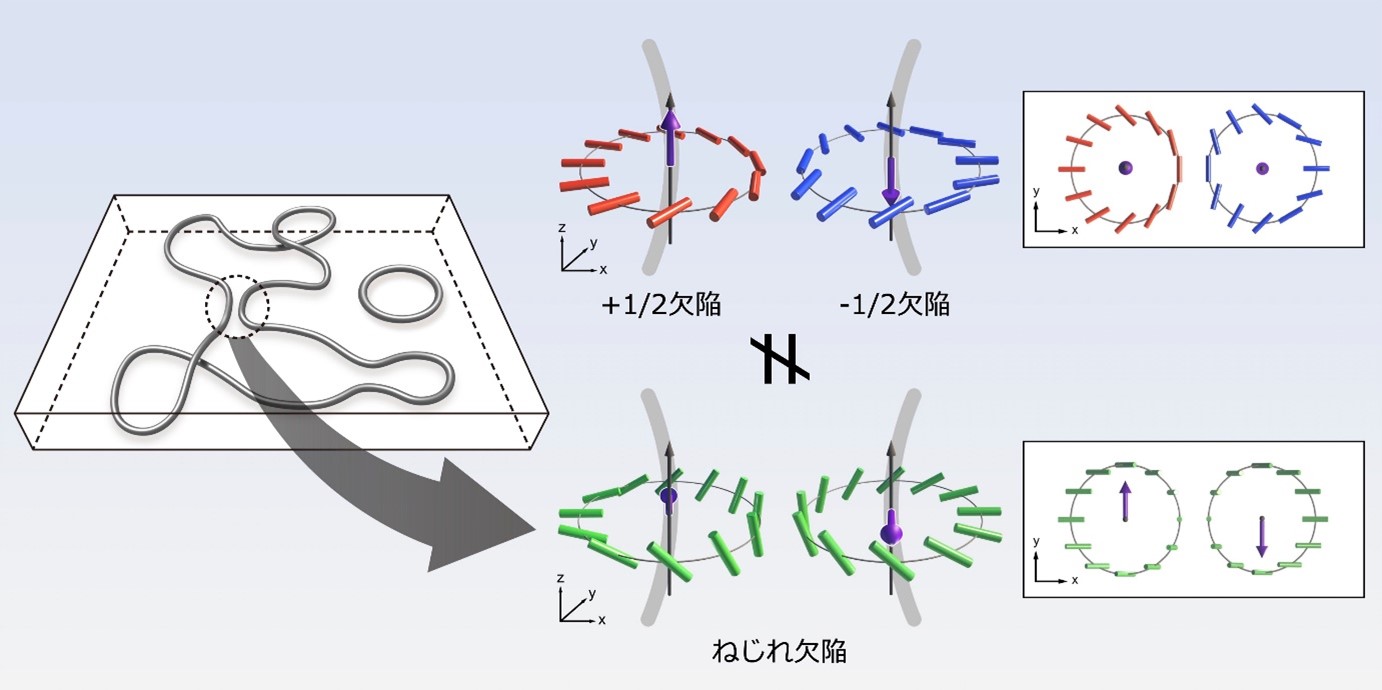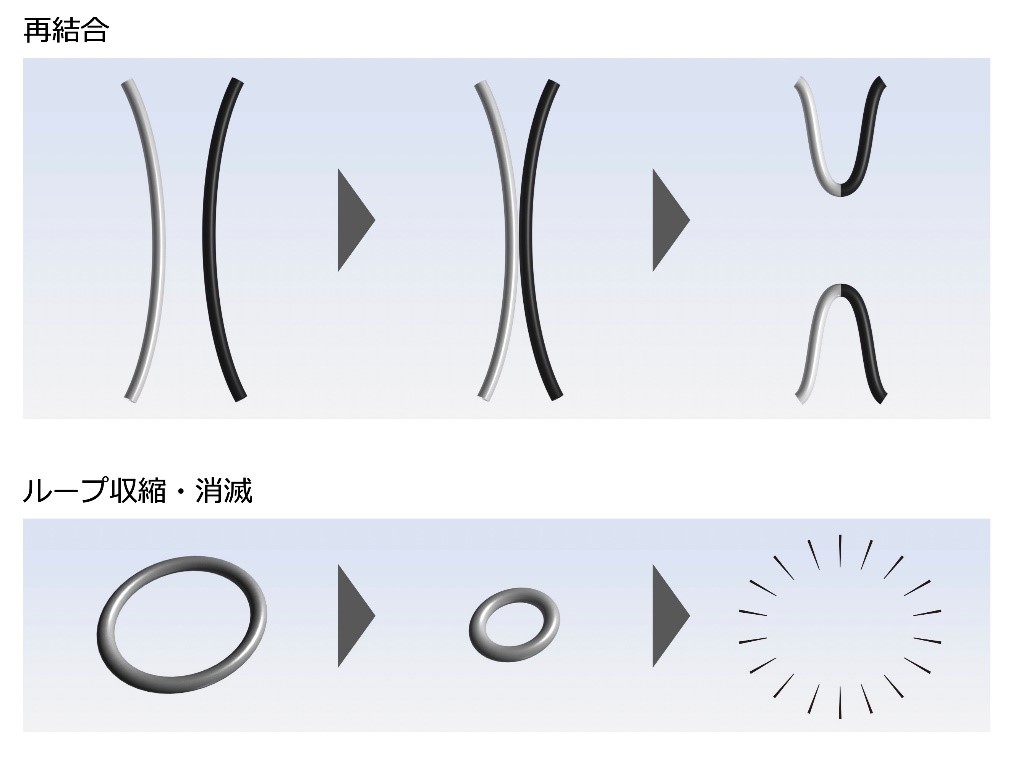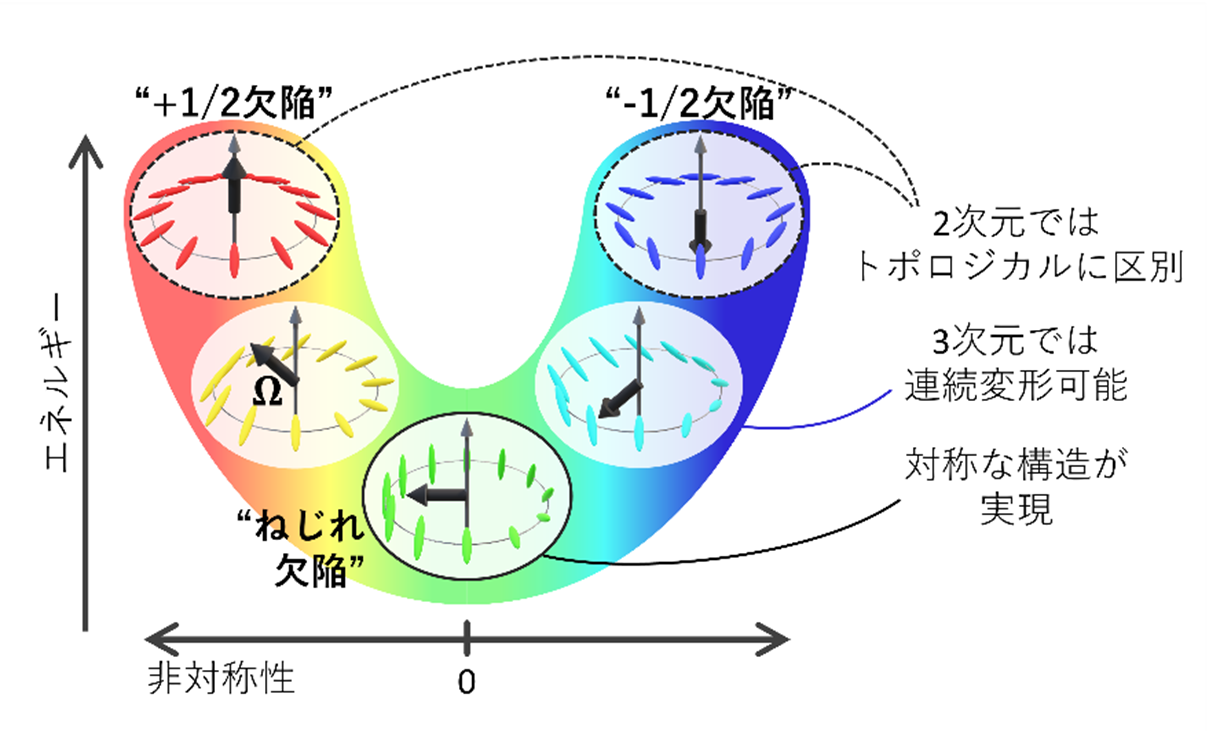DATE2022.10.05 #Press Releases
Success in capturing the three-dimensional movement of topological "strings" generated in liquid crystals
Disclaimer: machine translated by DeepL which may contain errors.
- To propose cross-disciplinary mechanisms that topology connects
Yohei Zuji (Department of Science, 2nd Year Doctoral Student)
Kazumasa Takeuchi, Associate Professor, Department of Physics
Key points of the presentation
- The three-dimensional motion of line defects, which are topological "strings" in liquid crystals, was observed for the first time by direct fluorescence imaging of defects.
- Focusing on the phenomenon of recombination, in which "strings" reconnect with each other, we clarified the motion characteristic of 3D topological defects and discussed its mechanism.
- Since topological defects appear in various scientific fields such as cosmology, superfluidity, and biology and play an important role, clarifying their universal nature is significant not only for liquid crystals.
Summary of the presentation
Let's look at a fingerprint. The stripes run in roughly the same direction, but there are places where the direction is not aligned, such as whorls, branches, and horseshoe shapes (Figure 1).

Figure 1: Topological defects in a fingerprint. Two types of defects can be observed: +1/2 defects and -1/2 defects. Fingerprint photo from Wikimedia Commons (public domain).
Such locations are called topological defects because they originate in the topology (Note 1). Similarly, topological defects are found in liquid crystals, where elongated molecules try to orient themselves toward each other. The "string" topological defects found in liquid crystals can twist and move around in three dimensions, interacting with each other like the rails of a roller coaster (Figure 2). The behavior of such topological defects has been of interest in both science and engineering, but it has not been easy to directly observe their three-dimensional structure.

Figure 2: Schematic representation of a topological line defect and its structure. Some of the line defects observed in the experiment are about to recombine (left, dashed line). The analysis of the motion of this reconnection phenomenon (recombination) revealed that a structure called "torsion defect" (bottom right) occurs naturally in these line defects, which is different from the ±1/2 defect (top right) observed in 2-D liquid crystals.
Graduate student Yohei Zuji and Associate Professor Kazumasa Takeuchi of the Graduate School of Science, The University of Tokyo, discovered that the phenomenon of fluorescent dye accumulation on stationary defects can be applied to the observation of motion, and succeeded in capturing the motion of topological defects in three dimensions (Movies 1-3). In particular, he focused on a phenomenon called recombination, in which topological defects collide with each other and reconnect (Figure 3 upper), and analyzed the motion. Topological defects are a concept that appears widely in research fields other than liquid crystals, and this research is expected to lead to a deeper understanding of topological defects across fields.
Movie 1: 3D motion of topological line defects (playback at about 3x speed)
Movie 2: Recombination of topological defects
Movie 3: Reduction and annihilation of topological defect loops

Figure 3: Schematic diagram of recombination of line defects and loop contraction/annihilation
Publication details
Background of Research
A typical type of liquid crystal, called nematic liquid crystal, is composed of elongated molecules and has an orientation order that aligns the orientation of the molecules with each other. In the two-dimensional case, topological defects have the structure shown in the right side of Fig. 1. In the two-dimensional case, topological defects have the structure shown in the right side of Figure 1, where the orientation is rotated by 1/2 (180°) around the topological defect, and are called +1/2 defects or -1/2 defects depending on the direction of rotation. Topological defects interact and move with each other through liquid crystal elasticity (Note 2). In the 3D case, string-like topological defects (called line defects) are common (Figure 2 left). In the cross-section of a line defect, the orientation is rotated 180° as in the case of 2D defects, but the axis of rotation can point in either direction. Line defects move with deformation, bumping into each other and reconnecting (recombination), or forming loops that shrink and disappear (Fig. 3).
The nature and motion of line defects have been actively studied both from the viewpoint of scientific interest in themselves and from the viewpoint of applying the properties of defects, such as bending light and trapping colloidal particles, and are a major topic in liquid crystal research. Existing techniques allow us to observe the three-dimensional distribution of orientation rather than the defects themselves, and in principle it is possible to identify the location of line defects from the orientation, but in practice, imaging around defects involves various difficulties, and it is not easy to identify defect locations in three dimensions. For this reason, the numerous studies on line defects that have been conducted so far have mainly provided only two-dimensional information, especially with regard to motion.
Research Contents
In this study, we applied the phenomenon of accumulation of fluorescent dyes on stationary defects to the observation of motion, and by using fluorescent dyes as labels for topological defects, we succeeded in directly observing their three-dimensional motion with a confocal microscope (Note 3). The topological defects, which were generated by applying high voltage to the liquid crystal to cause a turbulent flow, were observed to move around and gradually disappear after the voltage was cut off (Movie 1). In this observation, we also succeeded in capturing phenomena specific to line defects, such as recombination and loop shrinkage/annihilation (Movies 2 and 3). A more detailed analysis focusing on the recombination of the approaching parallel type revealed both common and different properties from those of the motion of 2D defects. First, we investigated how 3D line defects approach each other during recombination, and found that the distance between defects is proportional to √(t0-t) as the recombination time. This is the same law as that for annihilation, in which 2-dimensional ±1/2 defects approach each other and disappear when they collide, and the same law holds for 3-dimensional line defects. In the case of annihilation of 2-D defects, it is known that the +1/2 defect moves faster than the -1/2 defect due to the flow field effect (Note 4), resulting in asymmetric behavior. At first glance, the motion of the line defects analyzed in this study was asymmetric as in the two-dimensional case, but by devising the analysis and excluding the effect of the surrounding region on the defect of interest, it became clear that the motion is actually symmetric, unlike the two-dimensional case. This difference in symmetry between 2-D and 3-D can be discussed in terms of topology and energy, as explained next. First, while ±1/2 defects can be distinguished as topology in 2-D, they cannot be distinguished in 3-D. This is because in 3-D, the rotation axis of orientation can be oriented in any direction, so that structures intermediate between +1/2 and -1/2 defects can also be taken, and the +1/2 defect can be continuously transformed from +1/2 to -1/2 defects, making ±1/2 defects and all their intermediate structures topologically equivalent (Figure 4 ). Some of these intermediate structures have symmetric motions when approaching (torsion defects, Figure 2), and in most liquid crystals, including the liquid crystal used in this study, these structures have lower energy than the others (Figure 4). Therefore, it can be considered that structures that are only allowed in three dimensions due to topology are indeed realized due to their energy stability, and this has been confirmed experimentally. Although the concept of topological defects is not limited to liquid crystals, a similar argument can be made for topological defects other than liquid crystals, and this "spontaneous symmetry restoration" mechanism (Figure 4) is expected to have generality beyond liquid crystals.

Figure 4: Conceptual diagram showing that symmetry not seen in two dimensions is recovered in three dimensions
Future Prospects
The visualization technique for 3D motion of liquid crystal topological defects reported in this study is expected to become an important tool for defect research, which has so far focused on 2D observations. In addition, topological defects play an important role not only in liquid crystals but also in a wide range of physics, such as quantum vortices in liquid helium and cosmic strings in cosmology. In recent years, the collective behavior of elongated cells and microorganisms in biological systems has come to be understood in terms of liquid crystal theory and the concept of topological defects, and the results obtained in this study may contribute to a wide range of academic fields involving topological defects.
This research was supported by the Japan Science and Technology Agency (JST) as part of the PRESTO project "Topological Materials Science and Innovative Functionality Creation (Research Director: Shuichi Murakami)" (JPMJPR18L6) and by the Grant-in-Aid for Scientific Research on Innovative Areas (JP19H05800, JP19H05800, JP19H05800) from the Japan Society for the Promotion of Science (JSPS) (Grant-in-Aid for Scientific Research on Innovative Areas JP19H05800, JP19H05144, JP20H01826, JP22J12144), JSR Fellowship and FoPM WINGS Program at the University of Tokyo.
Journals
-
Journal name Proceedings of the National Academy of Sciences Title of paper Scaling and Spontaneous Symmetry Restoring of Topological Defect Dynamics in Liquid Crystal Authors Yohei Zushi and Kazumasa A. Takeuchi* (author) DOI Number
Terminology
1 Topology
A field of mathematics that deals with properties that do not change with continuous change (e.g., continuous deformation, such as bending and stretching in the case of a figure). As an example often given, the shape of a mug with a handle can be changed to that of a donut by shrinking the cup part and expanding the handle part. By simply bending and stretching, without cutting and pasting, the mug and the doughnut can go back and forth between each other, so they are considered identical as topologies. In this example, they share the property "one hole," which is called a topological invariant. Similarly, a topological defect is a defect that does not change (resolve) with such a continuous transformation. In the example of fingerprints, even if the skin is stretched and contracted, the spiral, branching, horseshoe-shaped, and other patterns do not disappear. In the case of liquid crystals, +1/2 defects and -1/2 defects are topologically distinct in two dimensions because they cannot be transferred to each other by continuous deformation (±1/2 is a topological invariant and is called a winding number), but in three dimensions, they can be transferred by continuous deformation, so all structures, including those in the process of transferring topologically equivalent. ↑up
Note 2 Liquid crystal elasticity
Elasticity derived from inhomogeneity (non-alignment) of liquid crystal orientation. It can be classified into three modes of deformation: spreading, twisting, and bending. Since liquid crystal is a fluid, it does not exhibit elasticity related to stretching and shrinking as in ordinary solids. ↑up
Note 3 Confocal microscope
By using a pinhole to detect only light coming from a single point on the sample, this microscope has a spatial resolution in the depth direction not found in ordinary optical microscopes. Three-dimensional information is acquired by scanning the entire sample. ↑up
Note 4 Effect of flow field
Since liquid crystals have fluidity, it is necessary to treat changes in orientation, which is the average orientation of molecules, in relation to their movement as a fluid. ↑↑


